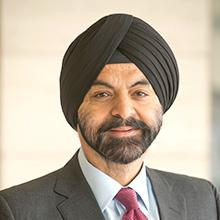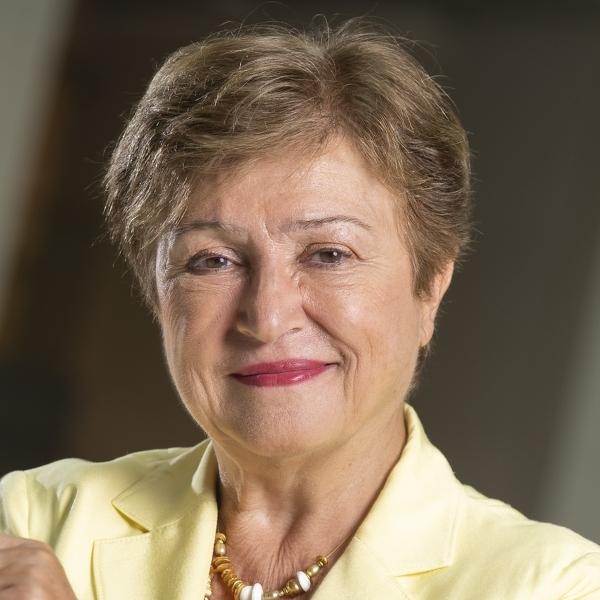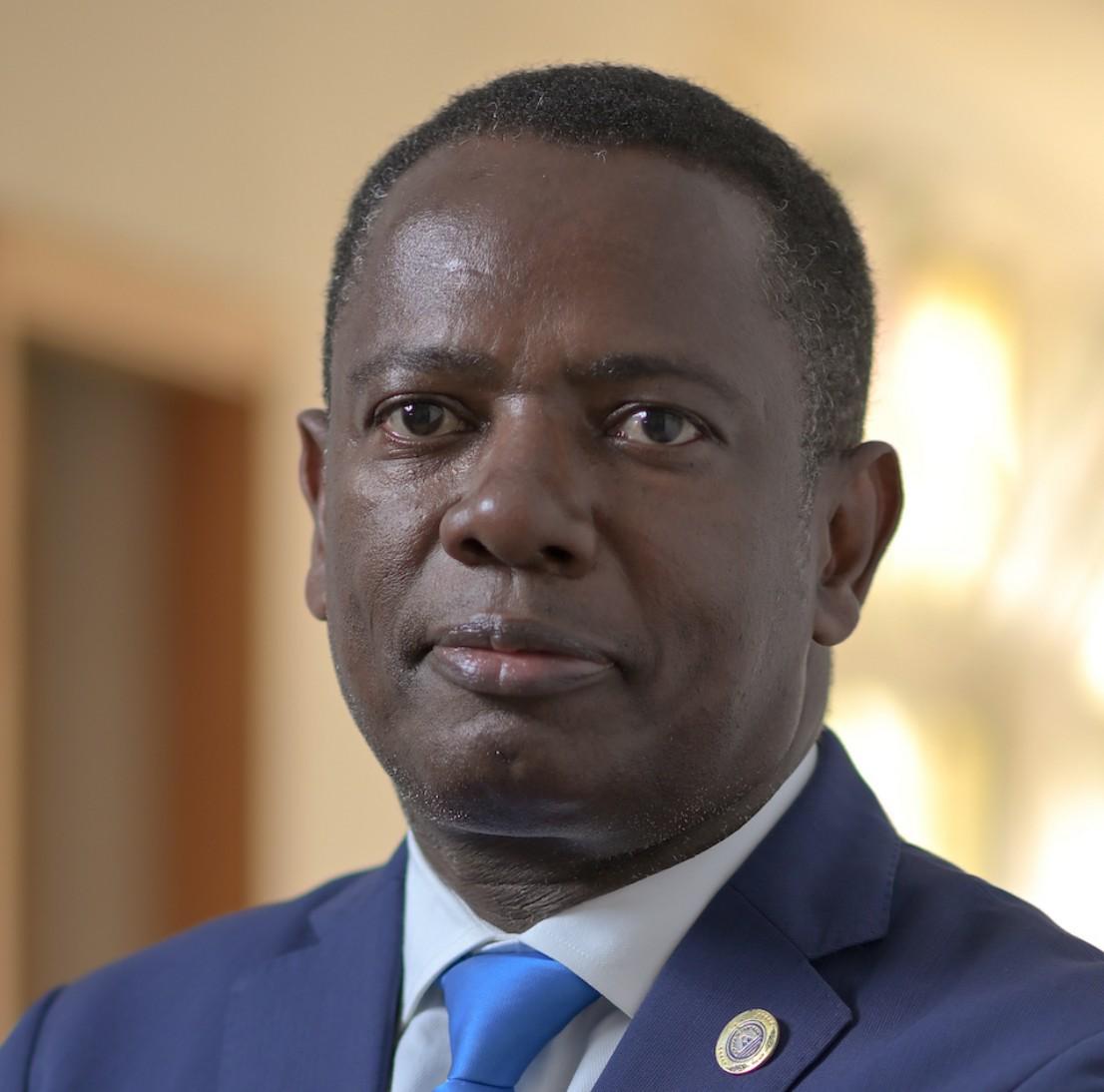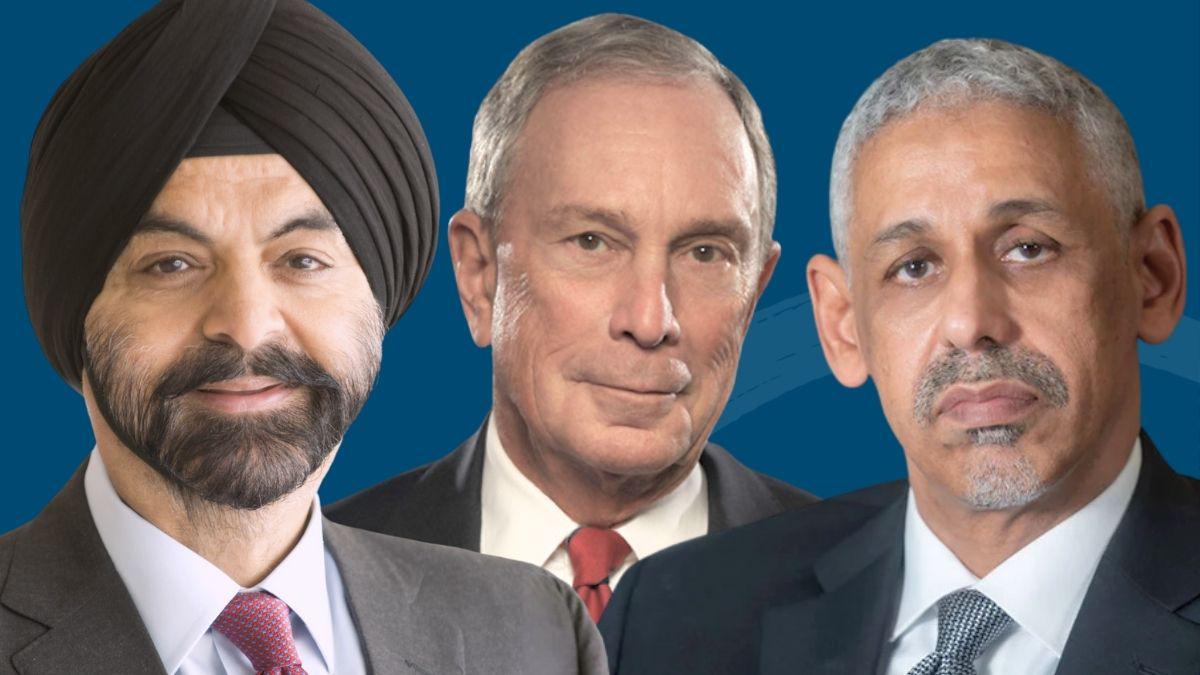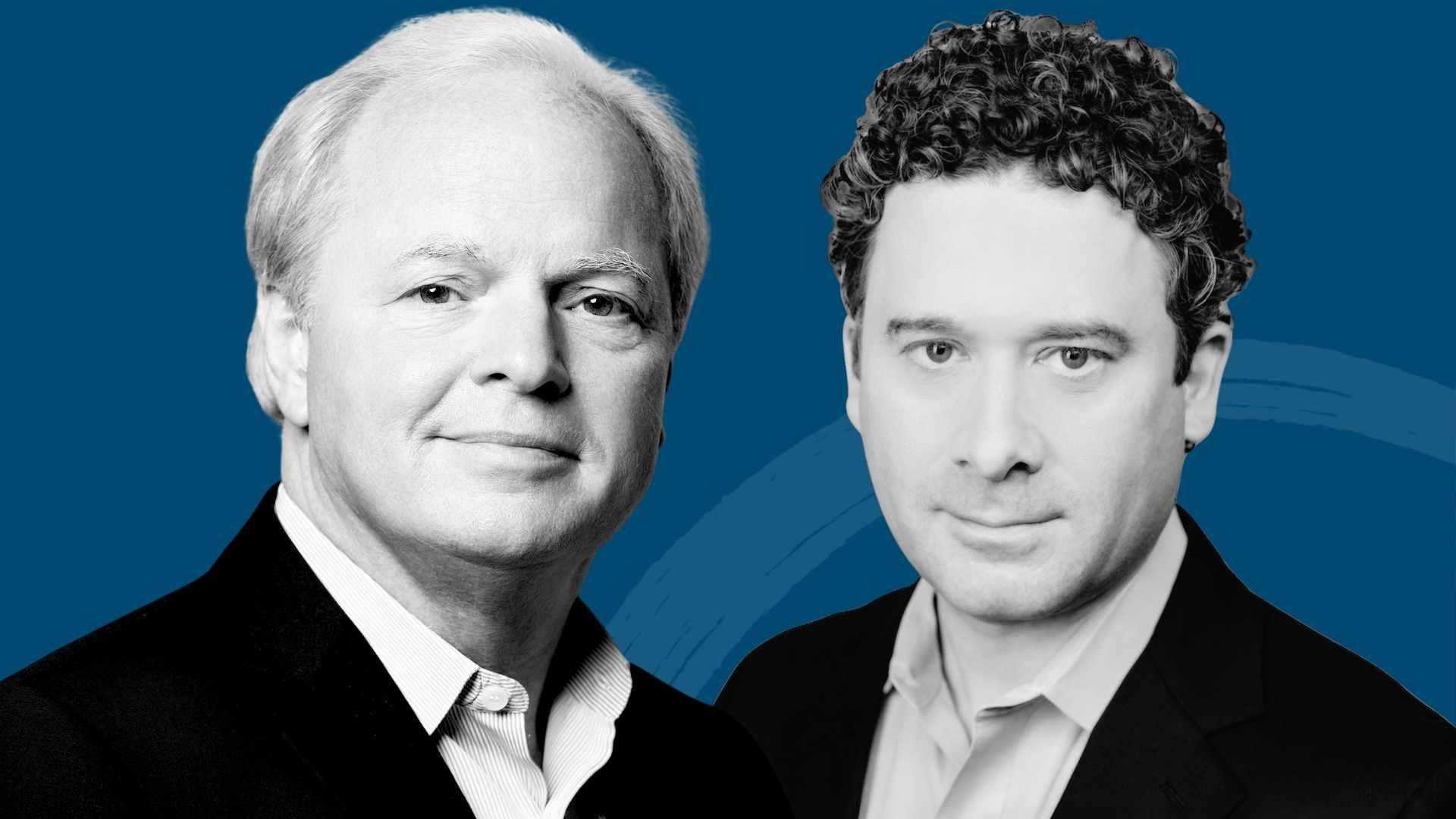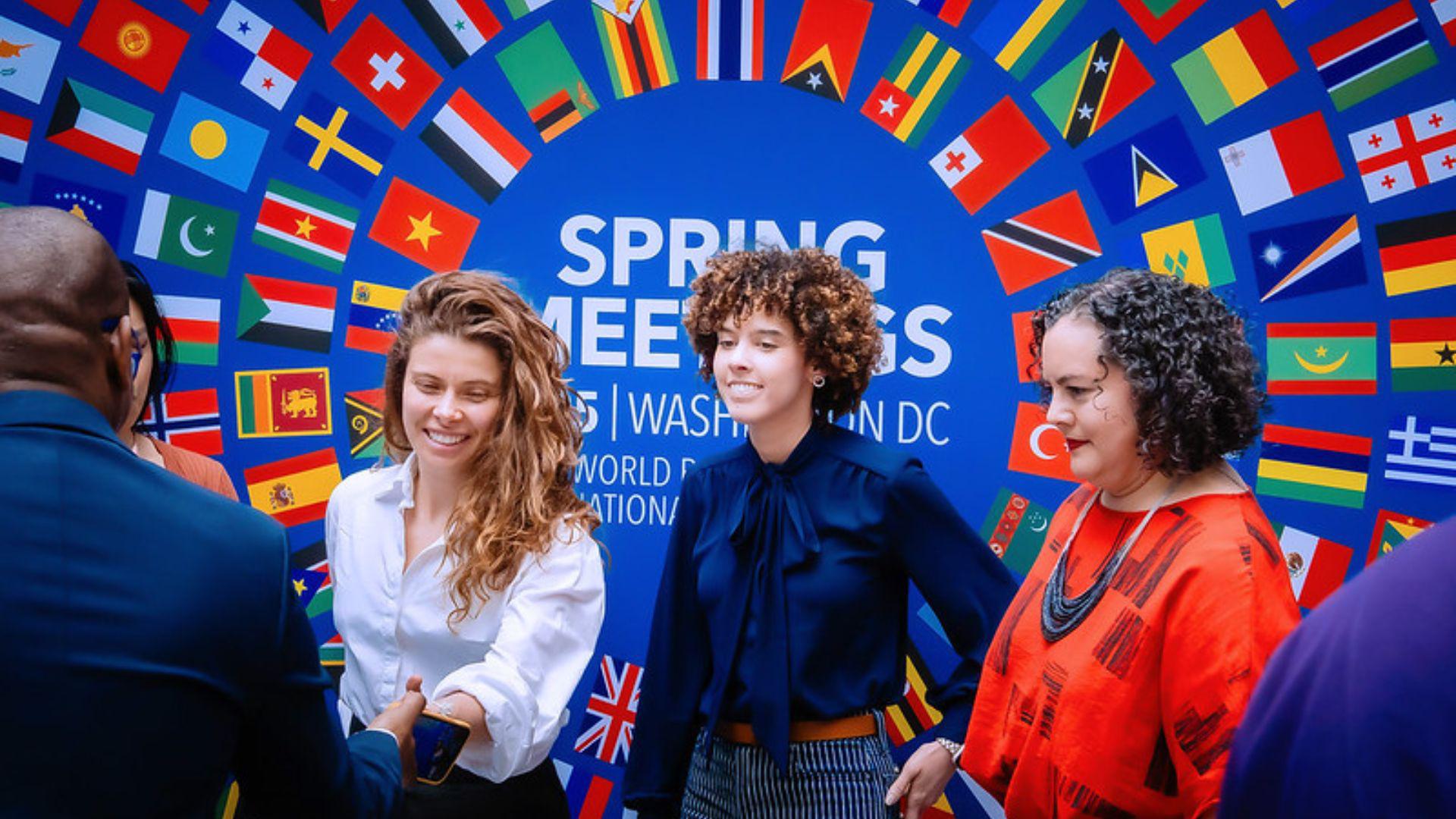[Music playing]
[Announcer] The meeting will start in five minutes. Please, take your seats and silence all mobile phones and portable electronic devices. Thank you.
[Music playing]
[Announcer] The meeting will start momentarily. Please, take your seats now and silence all mobile phones and portable electronic devices. Thank you.
[Music playing]
[Video begins playing]
[Narrator] Change. It’s constant in the human story, driving us to exceed, to innovate, to make life better. And when change improves lives, it becomes progress. Over the decades, we’ve helped guide a changing world through new frontiers of economic development, growth, progress, and prosperity. We are a firm foundation, a source of stability and insight, providing analysis and advice, capacity development, and lending. And we are partners, unlocking the potential inherent in everyone, unleashing entrepreneurship and strengthening institutions so everyone thrives. And through the years, we changed, adapting to new realities to help our members navigate shifting currents. In times of change, we will innovate and lead, and create possibilities for everyone so that change becomes progress.
[Applause]
[Olavo Avelino Garcia Correia] Let me speak in Portuguese. I call to order our session. Governors, ladies and gentlemen, it is my pleasure to call to order the Annual Meetings of the Board of Governors of the World Bank Group and of the International Monetary Fund for 2025. I welcome the Governors representing our member countries. On behalf of all participants, I should like to extend through the governor for the United States, our deep appreciation to the people of the United States for their warm welcome and gracious hospitality. It is customary in these Meetings for the Chair to address the Governors, and I shall proceed in this way. Thank you. Your Excellencies, honorable Governors, distinguished colleagues. It is for me an honor to welcome you to the Annual Meeting of the Board of Governors of the World Bank Group and the International Monetary Fund. Together, we’re stronger. Together, we will make the impossible, possible. We can make a peaceful planet, livable in a world free from poverty. It is our duty. My greetings to the President of the World Bank, Ajay Banga, and to the Managing Director of the IMF, Kristalina Georgieva. The partnership between those two institutions has been of strategic importance, including for my country, Cabo Verde. We are an upper middle-income country, enjoying macroeconomic stability and inclusive growth. It is our aim to become a high-income country. We want to become a developed country. In 1975, when we became independent, it looked impossible. Cabo Verde now has become a country of ambition. We managed to qualify for the World Cup for the very first time, the second smallest country in the world to achieve this feat. Thank you. We demonstrated once again that we may be small, but we can also be ambitious and think big. Yes, anything is possible for a continent as well. Africa has enough resources to build a glorious future. We have energy, water, arable land. We have young people, women, and diverse climates and ecosystems. It will all come together through good governance and leadership. We will work every day to create employment with dignified jobs and opportunities for everyone while building resilience. In August, a devastating tropical storm swept through the Northern islands of Cabo Verde, making it very difficult for the communities there. I want to express our deepest gratitude to the international community, to the World Bank and the IMF for the strong support. That strategy highlighted the need for climate governance and the importance of advisory support and broad technical assistance from the Fund and the Bank to enable us to create stronger buffers to face those emergencies. This underscores the need to invest in resilience so we can be prepared for the next shock, and to proactively plan for unforeseen events for Cabo Verde, as well as for many other nations. Economic diversification is needed to open growth, and to improve resilience against shocks, and to create jobs. This is the best way to lift people out of poverty. The road to diversification and economic integration requires substantial investment. The World Bank Group, the IMF, are working with us, bringing us not only financing, but also knowledge, innovation, cooperation, diversification, beyond tourism and agriculture. So, we have a greener agriculture that is bluer, that is smarter, digital economy that’s more inclusive. It’s not just a growth strategy. It is vital for us to survive. The private sector should be at the center of this transformation. I wish to commend the World Bank Group for its efforts to unleash the potential of the private equity to create jobs. If growth is to be private sector-driven, we will need instruments adapted to our economic and business sector profiles. We will need financial stability, strong institutions, resilient institutions, sound policies that will allow our enterprises to prosper, innovate, and drive prosperity for the country as a whole. Debt sustainability is a growing challenge for us. We must reduce the high charges to promote better borrowing practices and pave the way for timely and predictable debt restructuring. For decades, the World Bank Group and the IMF have been working together to help member countries to tackle their debt sustainability challenges. We have to make it more transparent. We have to support sound economic policies and offer financing on favorable terms. The Bretton Woods Institutions are at the center of the multilateral system. It is up to us to help the IMF and the World Bank by resourcing them with capital. This is the only way they can enhance the assistance they provide us with greater scale, speed, and impact. It is our duty because together we’re stronger. We’re united for a livable peaceful planet in a world free from poverty. Nobody can be left behind. Come rain or shine with vision, optimism, and confidence, scaling up our interventions with greater speed and impact will build a better for all. Thank you.
[Applause]
[Olavo Avelino Garcia Correia] At this time, I would like to call on the President of the World Bank, Mr. Banga, to address the Governors. You have the floor, sir.
[Ajay Banga] Good morning, everybody. Deputy Prime Minister Correia, thank you so much for your effort to help us with chairing this plenary. Kristalina, I am so glad to be celebrating our partnership once again. The recent events in Syria and Gaza give us reason to hope that peace is possible wherever conflict exists. The Democratic Republic of Congo, Sudan, Ukraine, Yemen, and beyond are also those that we have to keep an eye on. As we hope for peace, you have to also prepare for it. In that pursuit, we have convened expert groups to plan for the reconstruction in Gaza and in Ukraine. We’re drawing on regional specialists from both the public and private sectors. The Gaza group started a year ago. Their work is now being actively shared with the partners in the region who are working for the next steps there. Reconstruction is an essential part of our mandate. A service we stand ready to deliver wherever and whenever it’s needed and to the best of our ability. But at the same time, as an institution of development, we have got to keep our eye on the idea of conflict prevention. Alongside rebuilding what has been lost, we have to focus on creating the conditions for opportunity, the conditions for stability, because that is what motivates our actions and our decisions today. We are living through one of the most terrifically huge demographic shifts in human history. By 2050, more than 85% of the world’s population will live in countries that we call “developing” today. In just the next 10 to 15 years, 1.2 billion young people will enter the workforce. The estimates we have are they’ll be buying for about 400 billion jobs. That’s a large gap. The numbers are the numbers. It’s the magnitude that we’re talking about. Let me express that urgency in a different way. Four young people will step into the global workforce every second over the next decade. In the time it takes to finish my delivering these remarks, tens of thousands will cross that threshold, full of ambition, full of the desire for opportunity. The pace of population growth is the most staggering in Africa, which will be home to one in four people by 2050. Between now and then, estimates suggest Zambia will add 700,000 people every year. Mozambique’s population will double, while Nigeria will swell by about 130 million people, firmly establishing itself as one of the most populous nations in the world. These young people, their energy, their ideas, they will define the next century. With the right investments, focused not on need, but on opportunity, we can unlock a very powerful engine of global growth for all of us. On the other hand, without purposeful effort, their optimism risks turning into despair—fueling instability, unrest, and mass migration—with implications for every region and every single economy. That is why, like we did in the prior Meetings, the pivot to jobs. Jobs must be the focus, the center of any development, economic or national security strategy, generating growth, which enables an environment for jobs, that has to be center. The point is, what do we mean by a job? It can mean working for a company, advancing through it to higher levels, or it can be that you’re employed at a small business, but it could also mean that you’re starting out in your own as an entrepreneur. I’m losing the
[audio cuts off] in a loose fashion, but the idea is the chance for dignity, the chance for earning. It’s more than a paycheck. It’s what allows both women and men to pursue their aspirations. It is purpose, it is dignity, it is hope, it is optimism. It is the anchor that holds families steady. It is the glue that keeps societies together. It is the straightest line to stability, and it is the best progress because once you achieve it, it is very hard to reverse. And that is why we have refrained what we do—how we measure it, how we deliver it—around this reality. Over the past two years, we have worked to move with more speed, with simplicity and substance. Average project approval times have been cut from 19 months to 12. Some projects have now approved in less than 30 days. We have consolidated our leadership in 40 country offices. We’re giving clients a single point of contact. By June next year, every country will have that structure. Our Knowledge Bank is being combined across the Group. It is focused on replicating solutions at scale. It’s what I call “stealing shamelessly.” It’s a good thing to steal ideas that work and take it to other places and scale them. While unifying corporate services also happening with services like budgeting, human resources, procurement, and real estate being brought together. 153 internal metrics have been replaced by a corporate scorecard with 22 outcome indicators—publicly seen on the web. Through new instruments in optimization, we’ve expanded financial capacity by about 100 billion, thanks to the generosity of many countries in this room. The MDB co-financing platform has grown, a pipeline of 175 projects. Of those, 22 are financed, that’s $23 billion. This was launched just a year ago. We’ve established a full mutual alliance framework with the Asian Development Bank. What that really means is you’re reducing duplication for clients. Now we’re working to expand this to the other partners. We’ve got something going with the EBRD, we’re working on the IDB and so on. We are developing an IFC2030 strategy to strengthen private capital mobilization. The point of all this is that these reforms are the foundation. The mission is to get jobs. Most jobs—nearly 90%—ultimately come from the private sector. They don’t all begin there, but that’s where they ultimately come from. Countries move along a continuum. Early on, the public sector drives job creation. Over time, private capital and entrepreneurship will take the lead. But the private sector—whether it’s large or small—local or global, they cannot do it alone. Entrepreneurs need the right conditions to start, to grow, to hire. Those don’t happen by accident. That is where we think we can bring something unique through our three-pillar strategy. The first, government’s lead—often with input from the private sector—to build the human and physical infrastructure that underpins the opportunity. It is roads, ports, electricity, digitization, education, skilling, healthcare. Our public arms—IBRD and IDA—finance these investments. They help countries use resources effectively and help to establish public-private partnerships. Second, a business environment with clear rules, a level playing field, and sound economic management. That means secure land rights, predictable taxes, transparent institutions, and so on—as well as responsible debt management and exchange rate policies. We support these reforms alongside the IMF through our Knowledge Bank using policy tools and performance response-based financing. Third, once the basics are in place, we help the private sector scale and reward risk-taking through IFC and MIGA—providing capital equity, guarantees, and political risk insurance—all that backed up by ICSID for the settlement of investor disputes with sovereigns. That’s the range of things we can provide in one shop, but then they have to be one shop. This continuum of foundation, policy, and capital is how we translate ambition into jobs. It’s how we move from potential to paychecks in people’s bank accounts. We have identified five sectors with the potential to create these jobs in these countries: infrastructure and energy, agribusiness, healthcare, tourism, and value-added manufacturing—including the crucial minerals we all need for our energy and digital transitions. The important thing is these are not aid-dependent sectors. They’re engines of growth. They’re capable of generating locally relevant jobs without replacing work from developed economies as the principal way of growing. That is not what we are trying to do, create locally relevant jobs. They help build the middle class that will fuel tomorrow’s global demand, including goods and services from the developed world. Over the past two years, we’ve launched a set of strategic initiatives across many of these sectors I just spoke about. These are not siloed plans. There is a method to the madness. They reinforce one another, and they bring together the full benefit of the World Bank Group alongside our partners, because they’re going to have to all work in concert to deliver results at scale. Our electricity strategy focuses on accessibility, affordability, and reliability while providing and managing emissions responsibly. It powers Mission 300, our effort to connect 300 million Africans to electricity by 2030 with the African Development Bank. Countries have the flexibility to choose what fits their needs, what fits their context, whether they’re upgrading a grid or they’re installing wind, solar, hydro, gas, and geothermal. We’ve also begun the work in partnership with the IAEA to offer nuclear support for the first time in decades. The goal is, remember, enough power to drive productivity for people and businesses. We set a goal to help deliver health care for 1.5 billion people. This December, we will bring together governments, investors, and innovators at a summit in Tokyo with the government of Japan and the WHO to drive this agenda forward. Indonesia is already leading the way. It’s committing to provide every citizen with an annual primary care visit on their birthday. Very simple but very powerful idea. An approach that could reshape the future of healthcare for 300 million people. Through AgriConnect, which we’ve just put forward and launched in this Annual Meeting, we’re helping smallholder farmers move from subsistence to surplus. We’re building an ecosystem around cooperatives that integrates financing for farmers and SMEs, links producers to markets, and harnesses digital tools like small AI. It’s underpinned by a pledge to double our financing to 9 billion dollars a year and mobilize an additional $5 billion from the private sector. Just recently, with our Board’s help, we are finalizing a minerals and mining strategy to help countries move beyond raw extraction into processing—and one-day—regional manufacturing so that more value and more jobs stay local. We expect to share this strategy in the coming months and move forward with that as one of the next big initiatives. How do we make all this real? Our day-to-day life is we begin with a single country partnership framework across the World Bank Group that is developed with the country’s leadership and our subject matter experts. The countries own this. We’re trying to make it as simple as possible. It’s meant to be five pages. I don’t mean five. It could be six or seven, but not 50. If the leadership of the country will not read that country partnership framework, and understand it, and embrace it, and instead give it to someone else to write an executive summary, we should write the executive summary ourselves for them because we owe it to them. Each framework is a long-term strategic plan that utilizes the full capacity of IDA, IBRD, IFC, MIGA, and ICSID around a focused set of priorities tailored to that country’s unique needs, tailored to its ambitions. In a country, it might mean an end-to-end mineral value chain. In another, it could be tourism, rooted in nature and culture, perhaps stronger health systems that heal and employ, or agribusiness ecosystems that lift smallholder farmers. The path is tailored, but the fundamentals are shared. Build infrastructure, set clear, predictable rules of governance, and support private investment—because that last one is where the jobs will come from. To each scale and free up our balance sheet for the toughest challenges, we have to unlock the full power of that private sector. It’s technology, it’s innovation, it’s capital. That’s why we are breaking down barriers to investment and creating conditions where private capital can deliver developmental impact. We’re advancing that roadmap, the private sector investment lab provided. We’re deploying tools and practical solutions across the institution, the first one being regulatory clarity, first deployed through Mission 300 with more applications underway, and our redesigned Knowledge Bank will carry that work forward at full pace. Guarantees, now managed centrally by MIGA and growing well. The idea is to triple the business by 2030. In one prior meeting, I said that Hiroshi is wrong, and we will, and I think I will be proven right that he was wrong and I was right, but we will see. Foreign exchange solutions with the IMF and Kristalina, your team is helpful on so many of these things, and it helps enormously that you were in the Bank, so you understand us well. With the IMF, we’re developing local capital markets in 20 countries. While the IFC has reached one-third of its lending in local currency, the idea, the goal is to hit 40% by 2030. Junior equity. Again, the IFC has done this. We have launched the Frontier Opportunities Fund, seeded by IFC’s net income, but it needs additional contributions from philanthropy and governments, but perhaps most transformational, an originate to distribute model, bundling assets into investable products to bring institutional capital into emerging markets at scale. That effort is being led by a former Standard and Poor’s CEO, Doug
[Douglas L.] Peterson, who’s helping us out with this. Just weeks ago, we completed our first transaction packaging 500 odd million dollars of IFC loans into rated securities, strong demand. The next challenge is supply. We’re building a sustained pipeline across the Bank and working with partners in the EBRD and other multilateral development banks to see if we can create the right numbers for the institutional investor. Each step lowers risk. It boosts confidence. It helps meet private capital halfway. But capital will not come without a strong foundation from the start. And that is why we have to focus on doing development right, resilient, fiscally sound, rooted in trust, and built to last, what we call smart development. Many countries today are trying to grow, create jobs and lift people out of poverty while facing drought, storms, and floods, often on shaky fiscal ground, eroded by debt, weakened by corruption, or deprived of the resources needed to move forward. Smart development essentially says you build physical resilience and institutional strength as you go along. That’s what our clients are asking for. That demand is reshaping our work. You can see the shift in the numbers. Last year, 48% of our financing qualified as having climate co-benefits under the way the shared MDB methodology works, which actually exceeded our own expectations. Within that, resilience made up 43% of the public sector portfolio, up from one-third a couple of years ago. Let me take a minute to explain what co-benefit formula is, what the heck is this thing, and why client demand is driving these results. When we build a road that connects a pharmaceutical manufacturer to a market, it is built of quality to withstand floods and doesn’t have to be rebuilt. That is counted. When we build a school or skills incubator with insulation and reflective roofs, so extreme heat or cold doesn’t impact learning, that is counted in climate co benefits. When we help a farmer access drought-resistant seeds and drip irrigation to increase crop yields, profits, and guard against dry periods, that is counted. If you build a corridor that transports goods via train instead of truck, something we’re all working hard to do, for example, in the Lobito Corridor, but also other opportunities in Africa, which makes freight move faster and cheaper, that is counted. Smart development is lasting development. The same demand is reshaping our work on institutions and public finance. More countries are asking for help to strengthen core systems. We’re trying. We’re launching a new generation of public finance reviews. The idea is to help governments redirect spending to high impact priorities, 14 are completed, 22 more are expected soon. Again, the IMF is very helpful with this. Helping to manage liquidity risks before they escalate, IDA net flows have reached 21 billion dollars in the last fiscal year, up from $12 billion three years ago. We’re deploying debt for development tools to ease burdens, free up resources. We started with Côte d’Ivoire. Now we have nine similar transactions in the pipeline—but really, truly—we have an appetite to do more. We’re working very closely with people like the IMF to accelerate debt restructuring under the G20 Common Framework while also advancing domestic revenue reforms, expanding financing, and supporting liability management. But to me, the most important topic here is we have to keep improving transparency by expanding the debtor reporting system to all G20 countries. We have to give all parties greater clarity and confidence. You cannot fix something which you don’t know the amount of. And as desire grows for tools that build trust, we’re responding, helping governments to fight corruption with data-driven tools, digital IDs linked to assets, better fraud detection, and AI that connects tax property and identity data. Over the past decade, we have supported 120 governments in this effort. We are currently working with 26 more to target corruption and illicit financial flows. And because even the best systems need capable stewards, our knowledge academy is equipping public servants to lead reform. More than 200 senior officials have already completed training. Six new tracks are launching in that academy in the coming weeks and months. So now we’re beginning to see what’s possible. In just two years, our annual financing has grown from $107 billion to $119 billion. Private capital mobilization has risen from $47 billion to $67 billion. Total commitments, including private capital mobilization, are now at $186 billion. We raised another $79 billion from private investors through bond issuances. That scale is translating into real impact. Since launching the new World Bank Group Scorecard in 2024, let me give you a few numbers. We’ve helped 20 million farmers access technology, inputs, and markets. 60 million people have been connected to electricity. 70 million people have got an education to develop a skill, and 300 million experience quality health and nutritional services. They’re not just larger numbers. What they reflect is clear, sharp focus and a shift in the mindset of all the terrific people in the World Bank Group. It treats development not as charity, but as strategy. It sees jobs not as a side effect, but as the outcome of development done right, because when we focus on jobs, we are not turning away from health care, from infrastructure, from education or energy. We are helping economies grow so we can create the jobs by doubling down on those very things like health care, and education, and energy, and infrastructure. A job is what happens when a school leads to a skill, when a road leads to a market, when a clinic keeps someone healthy enough to work, when energy powers a business. That’s what a job is. That is how our efforts come together. That is how we turn investment into impact, and that is how we deliver what people most want, what they need the most, and what they deserve the most: a job. A chance, a future, and dignity. Thank you very much.
[Applause]
[Olavo Avelino Garcia Correia] Thank you very much, Mr. Chairman, Mr. Banga, for that inspiring speech. At this time, I would like to call on the Managing Director of the International Monetary Fund, Madame Georgieva, to address the governor as you have the floor, ma’am.
[Applause]
[Kristalina Georgieva] Deputy Prime Minister Olavo Correia, thank you, and may my future travels take me to the beautiful shores of Cabo Verde and the soulful melodies of Cesária Évora—or perhaps even to a football victory chant! Congratulations to your national team for qualifying for the World Cup for the first time in your country’s history. Dear Ajay, I cannot think of a better partner to have at the Bank than you. Thank you for your remarks, and thank you for your total and tireless focus on jobs. As you point out, Ajay, the world confronts a great demographic divide. Let’s look at the world map: first, we see a set of countries grappling with aging and shrinking populations; then a group in the middle; and finally, a large section of Africa, parts of the Middle East and Central Asia, where population growth is surging, as is a youthful workforce. All of these countries are our membership. To all of you, a very warm welcome. Let me state upfront that any analysis I may share with you today reflects the collective wisdom of the IMF’s talented and dedicated team coming from 172 countries.
[Applause]
[Kristalina Georgieva] All IMF management and staff in this room: please stand and be recognized.
[Applause]
[Kristalina Georgieva] From our brand new First Deputy Managing Director, Dan
[Daniel Scott] Katz, to the rest of the senior management team, to all! Thank you. Since we last met here in this big hall on October 25, 2024, uncertainty has shot up, up, up—yet global sentiment is holding. In other words, we have a mix of anxiety and resilience. Today, I would like to reflect on both. First, the anxiety. From technology to geopolitics to climate to trade, change is unsettling. The world trading systems that delivered so much for so many is being shaken to its core for many reasons, including because the playing field wasn’t truly level and the people left behind received too little help in retooling for new and better jobs. We see assertive nontariff measures ranging from import licensing—and Ajay talked about that—to export controls and port fees, with subsidy counts capturing only part of the picture. We see non-market industrial policies and exchange rate distortions. And of course, we have US tariff rates shooting up this year. But here is a key fact. 188 of our 191 member countries have so far avoided tit-for-tat tariff actions. Having noted that trade barriers hurt both growth and productivity, having urged policymakers to preserve trade as an engine of growth, I welcome this restraint by most countries—although, surely, there will be more changes to come. At this point, despite all the turbulence, we estimated that 72% of world trade is still being conducted on most favored nation terms. Countries take their lowest bilateral tariff rate and offer it to all of their trading partners. Simple, not complex. Trade is not a zero-sum game. Provided firms can maintain diversified and robust supply chains, provided governments can retain their strategic autonomy and assist those who lose out from trade, and provided—this is very important—external balances are not unsustainably large, imports and exports enhance welfare. No wonder the current uncertainty around trade policies and the risk of losing trade as an engine of growth are creating anxiety. So let me rotate to resilience. Despite the sweeping policy shifts we have seen this year and defying many expert predictions, the global economy has held reasonably well thus far. World growth is projected to slow from 3.3% last year to 3.2% in 2025 and 3.1% next year—slower than needed and below what we forecast one year ago, but not a dramatic slowdown. One reason for this resilience has been something that Ajay advocates for all the time, private sector, private sector adaptability as seen in the import frontloading, the stockbuilding, and the supply-chain strengthening. Years of robust profits have allowed exporters and importers to squeeze margins, cushioning the price impact of higher tariffs on consumers, at least for now. The other reason is more of a double-edged sword. Private sector investment in artificial intelligence, especially in US, is booming. This is propping up US and world growth and delivering supportive financial conditions for all. This is where optimism—in this case about the genuine potential of AI—risks becoming complacency. From the railways to the Internet, the history of financial market responses to pathbreaking new technologies is a story of overestimation and market correction. Here, for instance, we see a snapshot of the dotcom episode and its impact on growth. The world should embrace AI, but embracing it doesn’t mean not being mindful of risk, doesn’t mean not managing these risks. So how can we do it? We need strong financial sector oversight, alert to excessive risk-taking and the growing links between banks, non-banks, and crypto, and we need judicious monetary policy. This and other cross-cutting advice punctuate our multilateral surveillance, where our World Economic Outlook, Global Financial Stability Report, and Fiscal Monitor—all released this week—shine light, lower the temperature, and propose a path forward. Our bilateral surveillance, delivered via regular consultations with all our member countries, advanced emerging and low income alike—as well as our Financial Sector Assessment Programs— distill our multilateral advice into tailored policy recommendations country by country. I want to stress we cooperate very closely with the World Bank, with the work the Bank does at the country level. In meeting after meeting this week, I have advised finance ministers and central bank governors not only to mitigate the near-term risks, but also to look beyond them—preserving independent, accountable, and effective institutions, and finding driving, capturing, and delivering the opportunity that change always brings. We see three medium-term objectives. One, repairing governments’ finances. This is necessary so they can buffer new shocks and attend to pressing needs without driving private sector borrowing costs up. No finance minister should simply wait for faster growth to come to the rescue. On the contrary, fiscal consolidation can release resources to support private sector-led growth. Two, domestic and external rebalancing. This is necessary to ensure that excessive macroeconomic imbalances do not emerge as a spoiler. We need fiscal consolidation in some places, and policies to lift domestic demand in others. Three, lifting trend growth. This is essential for economies to generate more jobs, the jobs Ajay talks about, more public revenues and better public and private debt sustainability. Lifting growth on its own requires three things. One, regulatory housecleaning to unleash private enterprise; two, deeper regional integration; and three, preparedness to harness artificial intelligence. Regulatory housecleaning and regional integration are closely interlinked, including because many of the rules and regulations that tie down private enterprise at home are also restrictions to the movement of goods, services, people, capital, and ideas across borders. Many regulations double up as nontariff barriers, and nontariff barriers are a key part of the uneven global playing field. In this new world of bilateral and plurilateral deal-making, we see a diverse global trading landscape. Economies that are small and reliant on exports are at the receiving end of others, while those that are large and relatively less open—or control critical inputs to global supply chains—have negotiating power. Looking at the splash of dots showing countries by size of imports and trade openness, the bottom right quadrant is where we find the largest, least open economies. Many countries are seeking to build strength and find voice through cohesion. Here we see a selection of the world’s trading blocs, each enjoying more size and heft than its member countries individually. Our advice to the world’s trading blocs, reduce your internal frictions, and press forward with integration for resilience and growth. Finally, the other potential accelerator of global productivity growth is artificial intelligence. We at the Fund expect real gains, but our estimates are in a wide range, a global productivity growth uplift of between 0.1 and 0.8 percentage points per year. AI will also take away millions of today’s jobs and reshape millions of others, and policymakers need to help ease the transition. Old professions will fade, new ones will rise: big-data specialists, fintech engineers, machine-learning experts, and so on. Such churn is not uncommon. Recall how the automobile replaced the horse and buggy, but this time it is happening very fast. The key to maximizing the productivity gains and managing the fallout of AI is preparedness. Our research finds Singapore, US, and Denmark in the lead, while many others trail some way behind. As a transmission line of global best practice, the IMF will assist all members with a focus on managing the macroeconomic implications. Internally, we are, of course, pressing forward with AI adoption of our own, including to put more knowledge at the fingertips of our members. We are enhancing our productivity while preserving our trademark budget discipline. The IMF covers its operating expenses from own revenues with zero reliance on annual appropriations and maintains a deep commitment to leanness. Despite the increasing complexity of the world economy and the expansion of the services we provide to our members, our administrative spending today, in real terms, is about the same as 20 years ago. Our work in capacity development includes operational advice with almost 3,000 projects delivered in the last year; training with over 500 courses serving over 19,000 officials over the same period; and convening, which last February included our first-ever emerging market conference in Al Ula, Saudi Arabia, co-hosted with Minister Al‑Jadaan. Our lending activity, anchored by macroeconomic adjustment and conditionality, currently includes programs with 43 countries, with 37 billion dollars approved since last October, of which almost 5 billion dollars has been to nine low-income countries. In an uncertain world, a well-resourced IMF is essential. In that regard, let me today repeat two requests to our members. First, on our quota base. We are pressing to get the 50% quota increase agreed across the finish line. I ask all member countries that have not yet ratified the increase to please do it expeditiously. Second, our Poverty Reduction and Growth Trust, our main vehicle for concessional lending to low-income countries. We are pressing forward with the reforms agreed last year to put the PRGT on a path to self-sustainability, which includes, one, distributing up to 9.4 billion dollars to an interim account over a five-year period, and two, getting to a point where 90% of the principle in this account is promised to the PRGT. To date, we have 20 countries—most recently India, and just yesterday, China. They have provided assurances. This is totaling 43%, but we need more. We need to get to the 90%, and I ask you for your support. Finally, there is one further method that I want to bring to your attention, and this is the Catastrophe Containment and Relief Trust, our vehicle to provide grants to help low-income members countries pay debt service owed to us if they face an exogenous shock, natural or public health disasters. Quite rightly, we have depleted it during the pandemic. We have to replenish it for the shocks to come. It is our ambition to be always there for everybody, but especially for our poorest members. We are talking about an amount that ranges in the millions, not in billions, but it makes a huge, huge difference. I hope that in these Meetings, we will open the discussion and close it expeditiously so we are ready for the next shock to come. Now I’m bringing my presentation to you to an end, and I want to do it somewhat lighter. In March last year, I gave a speech at Cambridge University on “The Economic Possibilities For My Grandchildren” in which we animated some famous words from the great John Maynard Keynes. Here we have this synthetic audio again.
[John Maynard Keynes, AI voice] In the long run, almost anything is possible.
[Kristalina Georgieva] Now, 18 months later, please see our new AI avatar of Mr. Keynes sitting in this very hall!
[John Maynard Keynes, AI avatar] Eighty years on, I am greatly encouraged, I must confess, by the enduring value of these two institutions.
[Kristalina Georgieva] So congratulations to our 80th anniversary, and no better way to end with a little bit of fun. Yes, there is anxiety that changes bring, but we are optimistic. Let us feel our spirits lifted by the human progress that we have seen and the years to come will surely bring. Thank you.
[Applause]
[Olavo Avelino Garcia Correia] Thank you, Madame Georgieva. Thank you for your speech. Very inspiring as well. Challenges in everything to do with trade, economy, and fiscal arenas. Thank you so much for your statement. We will now turn to the formal the business of the institutions. We have before us the reports and recommendations of the Joint Procedures Committee. Report 1 covers the business of the IBRD, the IFC, and the IDA. Report 2 covers the business of the Fund, and Report 3 concerns matters of common interest to all of the organizations. We also have the report of the Procedures Committee of the Multilateral Investment Guarantee Agency. On the basis of the recommendations put forth by the Joint Procedures Committee and the MIGA Procedures Committee, I propose the adoption of these reports and the recommendations contained therein. As I see no objections, the reports and recommendations are hereby adopted. Turning now to matters related to the International Centre for the Settlement of Investment Disputes, I will now give the floor to Mr. Banga as the Chair of the Administrative Council of this body to take the floor. You have the floor, sir. Mr. Banga.
[Ajay Banga] Thank you very much. The Annual Meeting of the ICSID Administrative Council is now open, and Ms. Aradhana Kumar-Capoor will introduce the items for consideration by the Council.
[Aradhana Kumar-Capoor] Thank you, Chair. There are two items on the ICSID agenda this year that call for the adoption of resolutions by the Council. First, to approve the 2025 to the ICSID Annual Report, and second, to adopt the administrative budget for fiscal year 2026. The draft resolutions have been distributed to the members earlier. It is proposed that the draft resolutions on the ICSID 2025 Annual Report and the ICSID administrative budget for fiscal year 2026 be adopted.
[Ajay Banga] I take it that the two resolutions are adopted. The 2025 Annual Meeting of ICSID Administrative Council is adjourned, and I’m going to hand it back to the Chair.
[Olavo Avelino Garcia Correia] I would like to thank Mr. Banga and Ms. Kumar-Capoor. Now, I would like to take this opportunity to thank the Governors of the World Bank Group and the International Monetary Fund for the honor to have served as Chair of this session. I thank you on my behalf and my country to have chaired this joint session. I would like to thank you for your support and cooperation. I also like to express my deep appreciation to Mr. Banga and Mrs. Georgieva for their leadership of our two institutions. I also recognize the commitment of the staff of the World Bank and the Fund for carrying out the vital work of these institutions. I would like to thank also Ms. Kumar-Capoor and Mr.
[Ceda] Ogada, as well as the staff of the secretariat of both institutions for the successful organizations of the Meetings. I would also like to thank the two Vice Chairs, the Governors for Peru and the Arab Republic of Egypt. I wish to congratulate the Governor for Paraguay, who has been selected to chair for the coming year. An applause for the Governor for Paraguay.
[Applause]
[Olavo Avelino Garcia Correia] I would I wish all the Governors and Delegates a fruitful and productive Meeting and a safe journey home after the completion of our work. I look forward to seeing you next year in Bangkok, stronger, with more energy, with a greater spirit of reform, so that we create more jobs and more opportunities for our citizens all over the world. I hereby adjourn this Meeting of the 2025 Annual Meeting of the IBRD, IDA, IFC, MIGA, and the IMF. To all of you, thank you, and I adjourn this meeting. Thank you very much.
[Lively music]


